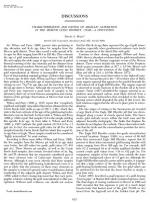Добрый день, Коллеги. Важное сообщение, просьба принять участие. Музей Ферсмана ищет помощь для реставрационных работ в помещении. Подробности по ссылке
Characterization and dating of argillic alteration in the Mercur gold district, Utah - a discussion
Wilson and Parry (1995) present data pertaining to clay alteration and K-Ar age dates for samples from the Mercur gold district. Their data record a wide spread of K-Ar ages for illite ranging from 98.4 to 226 Ma. They estimate the age of gold mineralization to be between 140 and 160 Ma and explain the wide range of ages as functions of partial thermal resetting of the clay minerals and the distance from the hydrothermal conduits. Morris and Tooker (1996) in their discussion of this paper, point out that a Mesozoic age for gold mineralization at Mercur is incompatible with several lines of long-standing regional geologic evidence that suggest a Tertiary age. In their reply, Wilson and Parry (1996) defend their position for a Mesozoic age of mineralization in part by relying on new 40Ar/39Ar age data and the fact that none of the 22 age dates is Tertiary. Although the research by Wilson and Parry may represent a good study of samples in the laboratory, there are several tenuous assumptions and contradictions of the geologic observations at Mercur that must be addressed.
Wilson and Parry (1995, p. 1197) report that "completely argillized and highly mineralized limestone obtained from the Carrie Steele fault yields an age of 152 ± 4 Ma" which they state is the best estimate of the age of the gold-bearing hydro-thermal event on this fault. In their table 4, Wilson and Parry (1995, p. 1209) report that sample CS-9 is the sample yielding this specific K-Ar age. In their table 3, Wilson and Parry (1995, p. 1207) indicate the gold content of CS-9 to be <1 ppb Au. In fact, the maximum gold value for all five of the samples from the Carrie Steele fault for which they report K-Ar age dates is 6 ppb. These samples would not be considered "highly mineralized" by most workers.
According to these same tables (Wilson and Parry, 1995), the five samples from the Mercur pit with K-Ar age dates carry better, but still rather low grade, gold values (47-810 ppb Au). These Mercur pit samples, as well as the Carrie Steele fault samples, also contain elevated values of As, Hg, Sb, and Tl, elements that are commonly considered part of the trace element suite of Carlin-type deposits such as Mercur. Although it may seem obvious that these samples were affected by the gold-bearing hydrothermal event, it is just as likely that the presence of these trace elements in the samples is related to ground-water remobilization during weathering of the adjacent gold deposit. Wilson and Parry (1995) admit in their closing statement that they lack petro-graphic evidence relating the gold mineralization to illite precipitation. Without such evidence, one should not assume
'Email: dmako@barrick.com
that the illite K-Ar age dates represent the age of gold mineralization, especially when geochemical evidence casts doubt on the association of the dated illite with gold.
Contrary to their closing paragraph (Wilson and Parry, 1996), there is abundant evidence that the gold mineralization is younger than the Tertiary magmatic events of the Mercur district. These events include the intrusion of the Porphyry Knob quartz monzonite dikes at 36.7 ± 0.5 Ma (Moore and McKee, 1983) and the intrusion of the Eagle Hill Rhyolite dikes and sills at 31.6 ± 0.9 Ma (Moore, 1973).
The most striking visual observation in the highwall exposure of the Sacramento pit is the ~20-m-thick zone of black, sooty organic material that appears to be ponded beneath the buff-colored sill of Eagle Hill Rhyolite. This organic material is observed to invade fractures in the rhyolite sill at its lower contact. Tafuri (1987) identified the organic material as as-phaltene and activated carbon, most likely derived from a precursor mobile hydrocarbon that circulated in the hydro-thermal system which deposited the gold. If this is true, the field relations suggest that the sill was in place prior to mineralization.
The late stages of mining in the Sacramento pit revealed a large block of the Eagle Hill Rhyolite sill that was down-dropped along a series of closely spaced faults. The Sacramento gold orebody occurs within this fault zone and the adjacent favorable stratigraphy. The faults that displace the rhyolite do not displace the orebody. These observations indicate that the faults and the mineralization postdate the intrusion of the sill.
The Eagle Hill Rhyolite carries low-grade mineralization in several locations. Stanger (1988), in a review of 86 drill holes that intersected Eagle Hill Rhyolite, reports that 44 percent of these holes intersected gold-bearing rhyolite with values ranging from 69 to 926 ppb Au. For example, drill hole SU-2 contained 84 m of weakly argillized rhyolite that carried erratic gold values from <34 to 412 ppb Au. For comparison, samples of the rhyolite from outside the mine areas show background values of <5 ppb Au. Although the Eagle Hill Rhyolite typically carries subore grades, it is apparent that a large volume of the rhyolite was affected by the gold-bearing hydrothermal system. The low gold values can be attributed to the fact that the dense rhyolite is simply a poor host rock.




